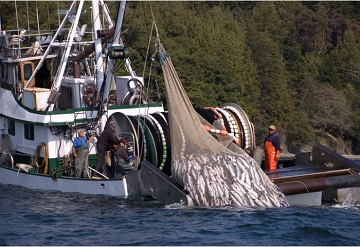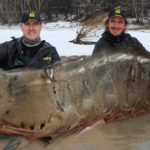A fishing boat carrying 2,600 gallons of fuel sank off the western shore of San Juan Island on Saturday, releasing an oily sheen that spread for 2 miles in critical habitat for the Northwest’s endangered orcas. The crew aboard the F/V Aleutian Isle radioed for help Saturday, saying they were taking on water. They abandoned their sinking ship and clambered into the skiff they normally use to maneuver the boat’s purse-like net to capture salmon. Two other salmon-fishing boats, the F/V Marathon and the F/V Intruder, rescued the five-person crew before the U.S. Coast Guard arrived. The 58-foot F/V Aleutian Isle sank to the seafloor in more than 100 feet of water about 2 p.m. How much of the boat’s fuel spilled is unknown. >click to read< 07:55
Tag Archives: Washington

NMFS survey delivers more bad news to Bering Sea crab fleet
A Bering Sea survey by federal scientists contains more bad news for Alaska, Washington and Oregon-based crabbers hoping for an upturn in upcoming harvests that last year fell to rock-bottom levels. The federal survey results for Bristol Bay king crab are bleak and crabbers have been warned that for a second consecutive year there may not be a fall harvest, according to Jamie Goen, executive director of the Alaska Bering Sea Crabbers. “We have got an emergency,” Goen said. “I’m trying to get Congress to act to help.” The National Marine Fisheries Service survey does offer hope for improved harvests three to five years from now, as young snow crabs grow to adult size. >click to read< 12:20

Port of Anacortes’ T Dock sees more than $14 million in annual commercial activity
Port commissioners voted earlier this year to replace T Dock with a new, upgraded dock, about twice the size and with a cost estimate of more than $7 million. With supply chain issues and rising costs of both supplies and construction, that number will likely go up, Port Executive Director Dan Worra said. The dock doesn’t bring in much money for the Port of Anacortes itself, but helps its tenants create money in their businesses. It also creates and supports jobs in this region, which is important to the port, he said. About $14 million in commercial activity happens through the T Dock each year. About $10 million of that comes from commercial fishing revenue, and $4 million comes through commercial maritime revenue, according to the report. >click to read< 10:29

F/V Aleutian Isle: Equipment on site, recovery will take 10 days once started
The Unified Command continues its response following the sinking of the commercial fishing vessel Aleutian Isle west of San Juan Island, Washington. Dive and vessel recovery equipment has arrived on scene. A mixture of oxygen and helium, known as heliox, is needed to dive at depths greater than 200 feet. The heliox has arrived on San Juan Island and is being prepared for use. Contractor, Global Diving, arrived on scene, anchoring a barge and crane which will be used to raise the sunken vessel Aleutian Isle for transport. >click to read< 09:45

Efforts to remove sunken vessel near Victoria are difficult due to conditions
A small fishing vessel remains underwater two weeks after it sank off the coast of San Juan Island, Washington, and the U.S. Coast Guard says removal efforts are difficult due to strong water conditions. On Aug. 13, the Aleutian Isle sank near the U.S. Island — approximately 25.6 kilometers east of Victoria. Dumping an estimated 9,854 litres of diesel oil, sheen covered several kilometers of water and threatened marine life while sparking a joint response between U.S. and Canadian agencies. Video, >click to read< 09:06
Divers hope to wrap up work, raise sunken fishing vessel near San Juan Island soon – Two weeks after an oil spill began off the west side of San Juan Island, divers began work that will allow them to plug a sunken fishing vessel more than 200 feet below the surface. >click to read<

Fishing vessel aground near Westport
The F/V Lady Debbie ran aground at about 4 a.m. near Cohassett Beach, according to the chief petty officer at U.S. Coast Guard Station Westport. The Coast Guard responded and at daybreak, the six people onboard the grounded boat walked to shore. No one was hurt. >click to read<, This story is breaking, and we will update it as we get more information. 12:46

Fishing vessel sinks off San Juan Island; Coast Guard responding to oil spill
All five crew members aboard the F/V Aleutian Isle were rescued by a good Samaritan as the vessel sank, the Coast Guard announced. Around 2 p.m., Coast Guard Sector Puget Sound got a report that the Aleutian Isle was taking on water near Sunset Point and was in need of emergency assistance. An Air Station Port Angeles MH-65 Dolphin helicopter, a Station Bellingham 45-foot response boat, and the 87-foot Coast Guard Cutter Swordfish (WPB-87358) all responded, the Coast Guard said. Once it knew that all crewmembers were accounted for, the Coast Guard started a pollution survey and began response efforts with partner agencies. Around 5 p.m., a visible oil sheen covering nearly 2 miles was seen on the water. >click to read< 07:37

Jury awards $595,000 in damages to Lummi Nation for 2017 fish spill
Cooke Aquaculture accidentally released tens of thousands of nonnative Atlantic salmon in 2017, threatening native Pacific salmon, and the Lummi Nation’s traditional reliance on them. In 2017, a floating industrial salmon farm in the Northwest’s Puget Sound broke loose, releasing tens of thousands of Atlantic Salmon into the ecosystem. The nonnative salmon, raised in crammed industrial scale fish pens and considered a threat to native Pacific salmon, quickly swam throughout the bay. The Washington Department of Ecology later found that the farm owner, Cooke Aquaculture, the largest privately owned salmon-farming agribusiness in the world, had neglected to take care of its equipment. >click to read< 13:43

Western Flyer sails again
The Western Flyer left for Seattle after seven years of intense restoration and rebuilding in Port Townsend, but she will make a detour on the way to her final destination for one last visit to the town that returned her to the ocean. The boat, known most famously as the vessel writer John Steinbeck and marine biologist Ed Ricketts chartered for a research trip to the Sea of Cortez in 1940, had been in Port Townsend undergoing restoration since 2015. On Wednesday, the Western Flyer embarked on stage two of its rehab when it was towed to Snow & Company boat builders in Seattle’s Ballard neighborhood. There, over the course of the next four or five months, it’ll get a new engine, rigging, hydraulics and mechanical systems. >click to read< 12:14

A piece of western Washington literary history heads back to sea
The boat John Steinbeck was on while writing The Log from the Sea of Cortez is embarking on a new chapter. The Western Flyer has been being refurbished in Port Townsend for the past nine years. Now, the 85-year-old boat is launching into Puget Sound once again. The painstaking voyage back to the sea begins with a bulldozer noisily hauling the 77-foot seiner out of drydock, inch by inch. It’s part of a journey Rom Welborn has been on since he first learned about the boat when writing a high school paper. “It changed my life and it still feels like it’s changing my life,” he said. >Video, click to read/watch< 11:27

Report: Removing Lower Snake River dams – Bill filed to save Snake River dams.
If four Lower Snake River dams were breached to support salmon recovery, the energy, irrigation, recreation and other benefits they provide to the Pacific Northwest could be replaced for $10.3 billion to $27.2 billion, according to a draft report released Thursday by U.S. Sen. Patty Murray, D-Wash., and Washington Gov. Jay Inslee. The report does not take a position on whether the hydropower dams should be removed, but finds that breaching offers the best chance to recover salmon runs in the Columbia and Lower Snake rivers,,, >click to read<
Republican representatives, led by Rep. Dan Newhouse, R-Wash., introduced federal legislation on Thursday to protect the four lower Snake River dams from being breached. The bill was introduced just hours before a draft study commissioned by Sen. Patty Murray, D-Wash., and fellow Gov. Jay Inslee, a Democrat, was released. The draft study concluded that it would be costly, perhaps requiring more than $27 billion, but the dams could be breached and their benefits replaced. It would be the action most likely to restore endangered salmon runs and benefit tribes, the draft study said. >click to read< 10:52

Seafood Industry Professions Raise Concerns About Reintroduction Of Sea Otters
West Coast Seafood processors says that their membership is concerned about a study on the impacts of sea otters on coastal fishing. The West Coast Seafood Processors Association says that they join other ocean stakeholders in a lack of confidence about concerns raised about the otters. “We remain very concerned that the issues we identified in our letter last year will not be adequately addressed in the Fish and Wildlife Service’s cost and feasibility study,” West Coast Seafood Processors Association Executive Director Lori Steele said. >click to read< 18:24

The U.S. Has Spent More Than $2 Billion on a Plan to Save Salmon – The Fish Are Vanishing Anyway.
The Carson National Fish Hatchery was among the first hatcheries funded by Congress over 80 years ago to be part of the salvation of salmon, facilities created specifically to replace the vast numbers of wild salmon killed by the building of dozens of hydroelectric dams along the Northwest’s mightiest river, the Columbia. Tucked beside a river in the woods about 60 miles northeast of Portland, Carson has 50 tanks and ponds surrounded by chain-link fencing. They sit among wood-frame fish nursery buildings and a half-dozen cottages built for hatchery workers in the 1930s. Today, there are hundreds of hatcheries in the Northwest run by federal, state and tribal governments, employing thousands and welcoming the community with visitor centers and gift shops. The fish they send to the Pacific Ocean have allowed restaurants and grocery seafood counters to offer “wild-caught” Chinook salmon even as the fish became endangered. photos, >click to read< 16:58

Retired Commercial Fisherman Jerome Lee “Jerry” Green Sr., of Westport has passed away
Jerome Lee “Jerry” Green Sr., 83, longtime Westport resident and former commercial fisherman, passed away on March 9, 2022, at his home in Westport, Washington. Jerry was born on Feb. 3, 1939, in Hayward, Wisconsin, the first boy born in the Hayward Indian Hospital and the eldest of seven children. In 1971, Jerry married the love of his life Joyce Johnson. They enjoyed working together in the commercial fishing industry and spending time in Alaska during fishing season. They built a beautiful life together, that included large family gatherings and spoiling all of the grandkids. Joyce passed away in 2007. Jerry built and owned several boats including Jer’s Joy, Lady Joyce and Early Dawn. >click to read< 15:04

NTSB: Hot Work Failures Led to Fire on Aleutian Falcon
The fire was reported on the commercial fish processor Aleutian Falcon on Feb. 17, 2021 while the vessel was docked for repairs at a shipyard in Tacoma, Washington. The Tacoma Fire Department responded and extinguished the fire four days later. No one was on board the vessel at the time of the fire, and there were no injuries reported. An estimated 20-30 gallons of hydraulic oil leaked into the water but were captured by a containment boom. The vessel was declared a total loss with an estimated value of nearly $16.5 million. >click to read< 09:38

All About the Fishing Fleet at Terminal 91
The factory trawlers, or fish processing vessels, of the North Pacific Fishing Fleet are back in Seattle after four months of harvesting pollock in the Bering Sea and Gulf of Alaska. The docks at Terminal 91 are buzzing with activity as crews unload their recent harvest and prepare to set sail again in late May. For more than 100 years, the North Pacific Fish Fleet, homeported at Terminal 91 and Fishermen’s Terminal, has fed the world and the economies of the Pacific Northwest and state of Alaska. Our region supplies 13% of the total U.S. commercial fisheries harvest by value. Commercial fishing activities at the Port of Seattle generated more than $671.2 million in business output in 2017 and supported 7,200 jobs. Learn more about the North Pacific Fishing Fleet, photos, >click to read< 10:16

J. M. Martinac Shipbuilding Corporation (Tacoma)
In January 1917, Martinac, with partners Martin Petrich (1880-1971) and William Vickat, established the Western Boatbuilding Company in Old Tacoma. In April, The Tacoma Daily Ledger reported the company employed 40 men building fishing boats up to 70 feet in length for use “in Alaskan waters, on the Columbia River and on Puget Sound” (“Fishing Vessels Turned Out Here”). Fourteen fishing boats worth $90,000 left the plant by the end of September, and the company found itself “receiving inquiries from all over the Sound” and “points in the Pacific Northwest” (“Builds $90,000 Worth of Boats”). While the venture was a success, In 1924, Martinac founded his own company, the J. M. Martinac Shipbuilding Corporation. While the company built some yachts, it primarily built fishing vessels. Photo gallery, >click to read< 21:08

‘Eat on the Wild Side’: The nation’s first registered apprenticeship program for commercial fishing
It’s called “Eat on the Wild Side.” It started as an idea by leaders of the Deep Sea Fisherman’s Union to recruit, train and retain a skilled and more diversified workforce. In July 2021, they contacted the Workforce Development Department of the Washington State Labor Council, AFL-CIO for help in setting up this new training program. And by December, they had created the nation’s first registered apprenticeship program for commercial fishing. The program, also known as the DSFU Inbreaker Program, began accepting applications in January and almost immediately had more applicants that they had boats/employers to handle the demand. >click to read< 09:21

British Columbia: Hooked on halibut: For many commercial fishers, it’s a family affair
The commercial halibut season is underway along the coast of British Columbia and boats are already starting to deliver the flat fish to dinner plates. From now until early December, the B.C. halibut fleet will haul in an estimated 5.7 million pounds of halibut. The Americans will take the lion’s share of this year’s 41-million-pound total allowable catch, nearly 80%, because their territory stretches over California, Oregon, Washington and all of Alaska to the tip of the Aleutian Islands and covers nine of the 10 designated halibut-fishing areas along the Pacific Coast. Tiare Boyes and Cheri Hansen weigh in on what it’s like to work on the water during the halibut fishing season. Photos, >click to read< 11:14

Federal Funding for Killing Sea Lions Might Help Cowlitz River Salmon
Though the actions taken to secure $892,000 in federal funding for the protection of Columbia River system salmon took place thousands of miles from Lewis County, the process could have positive impacts for fishermen of the Upper Cowlitz River and the Columbia basin as a whole. As a result of a joint effort between U.S. Representatives Jaime Herrera Beutler, R-Battle Ground, and Kurt Schrader, a Democrat from Oregon, the appropriations bill passed by congress will include funds to continue the Washington Department of Fish and Wildlife’s (WDFW) efforts to kill sea lions on the Columbia River, protecting salmon and steelhead. Sea lion extermination has been shown to be effective in protecting fish. >click to read< 11:35

Retired Commercial Fisherman/Dr. Roland August Hublou has passed away in Everett
Dr. Roland Hublou, 88, known affectionately by his many friends as “Doc” and “Hub”, passed away peacefully on February 9, 2022 in Everett, Washington. Roland was born on October 6, 1933 to his parents, Francis and Blanche Hublou, in Minot, North Dakota. Roland was an excellent dentist, practicing at the Everett Medical Dental Building until his retirement in 1997. Roland’s other love was fishing, which led him to his second career in the commercial fishing industry. He was an active and successful commercial fisherman with his sons, from 1973-2007, building three commercial gillnetters over the years; “Persistence”, the “Eagle Jack” and his final boat, “Doc’s Eagle”. He was elected President of the Puget Sound Gillnetters Association in 1980, and spent many years in all aspects of the fishing industry,,, >click to read< 21:35

NPFMC ponders changes in the halibut catch sharing plan
When the North Pacific Fishery Management Council adopted its halibut Catch Share Plan back 2014, charter operators were granted 125% of their historic catch at low levels of abundance, with that additional 25% coming out of quota for the commercial longline sector. Commercial longliners were assured that no further uncompensated reallocations would be considered, but now federal fisheries managers are doing just that. The Halibut Coalition is urging its membership of commercial harvesters to write to the governors of Alaska, Washington and Oregon expressing their views, as the representatives of those states on the NPFMC voted in favor of considering changes to halibut allocations. >click to read< 13:41

International Pacific Halibut commission raises most Alaska harvest limits for 2022
An uptick in halibut stocks along much of the Pacific coast means increases in total catch limits in every region of Alaska this year. The International Pacific Halibut Commission decided in its annual meeting last week to increase catch limits in every management region except for 2A, which covers the California, Oregon, and Washington coast, with an overall coastwide increase of nearly 6%. The increase comes after IPHC researchers informed the commission that halibut stocks were showing signs of rebounding from lows in the last five years, in part due to a large age class from 2012 becoming mature. The long-term trends of decline seemed to end in 2013, when the stocks began to climb again. >click to read< 14:37

This Gig Harbor fishing vessel is almost 100. Here’s the latest on its next life.
The wooden vessel, built in 1925, is looking better today. Now at the Harbor History Museum, it’s taking shape as a permanent exhibit that will tell the story of the boat and also the history of Gig Harbor’s commercial waterfront. The Shenandoah was built in the Skansie Shipyard. The Janovich family started fishing the boat in about 1967, and owner Tony Janovich donated it to the museum in 2000. Their largest catch was about 8,600 sockeye. The purse seiner was hauled out of the water in 2003, and crews have been restoring it since. Video, >click to read< 08:29

Salmon runs: Remove sea lions
Breaching the Snake River dams will not guarantee an improved salmon run. A better suggestion might be to remove the sea lions from the Columbia River and severely restrict fishing as our Canadian neighbors are doing for their Fraser River run. It is difficult for more salmon to get upstream when they are being overfished, and each sea lion consumes 15 to 40 pounds of fish per day. By John Crawford >click to read< 09:21

Cool ocean waters, abundant nutrients look good for Washington salmon
Scientific markers used to predict the health and productivity of marine species such as juvenile salmon were positive in 2021, the second most favorable since 1998, according to analysis from NOAA. Fisheries biologists are cautiously optimistic that those conditions will persist into the near future, supporting the health of juvenile, ocean-run salmon off the coasts of Washington and Oregon. The report looked at a number of oceanic health markers: atmospheric conditions, water temperature, salinity, oxygen levels, current movement, and biomass of Chinook and Coho salmon, along with food sources such as plankton and small crustaceans. >click to read< 13:55















































